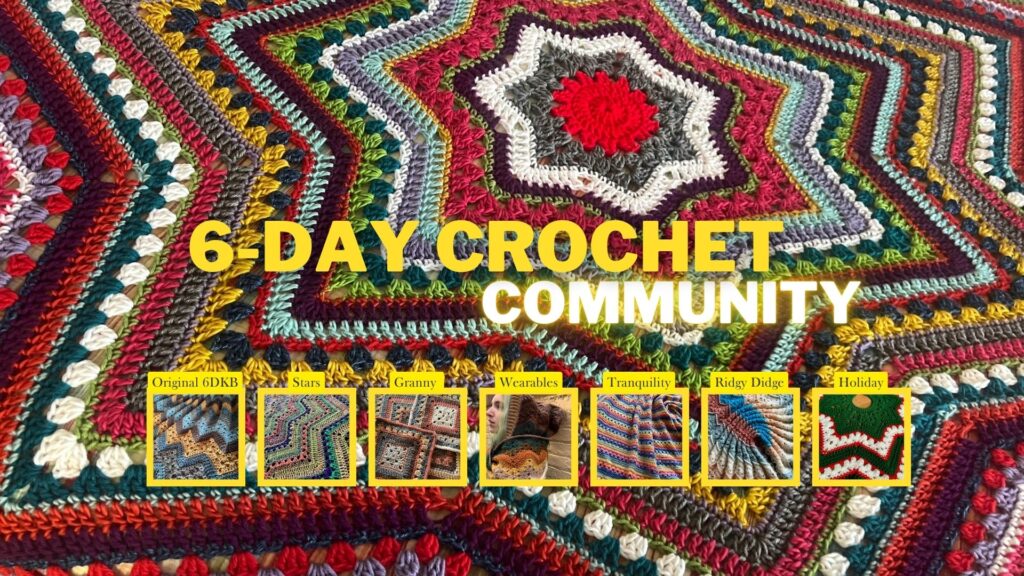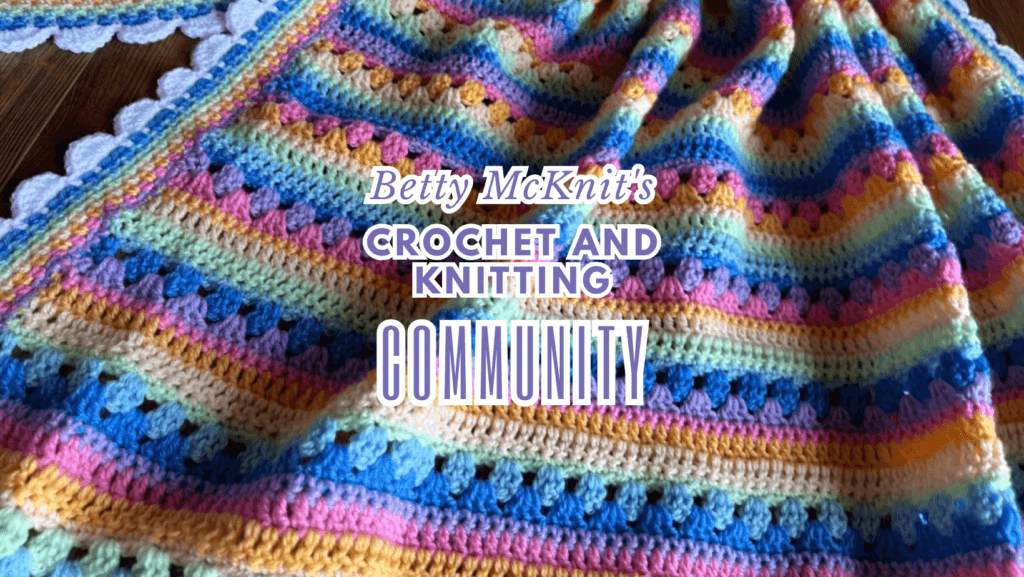6-Day Ridgy Didge Star Blanket
A variation of the classic crochet pattern the
6-Day Kid Blanket by Betty McKnit
This variation of the classic 6-Day Kid Blanket (6DKB) and 6-Day Star Blanket works from the center out into the shape of a seven-pointed star. It has an exciting textured stripe called the Ridgy Didge, conceptualized by Diane Kagay, Erin Boom Iske and Stephanie Pundt-Werner. Sue McKinnon and Katie Poli suggested the name.
This pattern is provided free with advertisements on this page. If you would like an ad-free .pdf, you can purchase one at the bottom of the page. The .pdf is the same as this pattern, with the exception of the ads.
Introduction
This fun and easy pattern is adaptable, perfect for crocheters of all levels of experience. It is easy enough for new crocheters and interesting and addictive for the more seasoned. It is just like the viral 6-Day Star Blanket, but has an adaptation of Round 6 to create a textured ridge. This blanket can be made in virtually any yarn, can be striped any number of ways, and you can make a blanket of almost any size you like. The border is a very simple reverse single crochet.
No one can make just one 6-Day Blanket, Star, Superstar, or Supernova, and now with this clever Ridgy Didge adaptation you will never run out of options.
This page contains affiliate links. If you click these links and buy something on the page they take you to, I may, at no additional cost to you, earn a commission. I only affiliate with products and companies I feel good about. Thank you for your support!
What’s the difference between this blanket and the 6-Day Ridgy Didge Superstar, and 6-Day Ridgy Didge Supernova Blankets?
- The 6-Day Ridgy Didge Star blanket has seven points and is based on the 6-Day Star Blanket, the easiest of all the 6-Day blankets. It has eight setup rows and is repetitive after that. I suggest first timers and new crocheters start with the 6-Day Star or Ridgy Didge Star and then attempt one of the other variations.
- The 6-Day Ridgy Didge Superstar is based on the 6-Day Superstar, has 14 points and comes out almost circular with chevrons. It has a more challenging setup but once the setup is complete it is repetitive (like the 6-Day Star).
- The 6-Day Ridgy Didge Supernova is similar to the 6-Day Supernova and has a total of 14 points: 7 larger points and 7 smaller points. It is the most complicated of all the star blankets, although not difficult to make, it is not mindlessly repetitive. Try the Supernova first and then the Ridgy Didge Supernova when you’re comfortable with the star and ready for a challenge.
- There are also shawl and holiday tree skirt versions of the 6-Day Star Blanket.
Details:
US Terminology (UK Conversions)
Skill Level: Easy
Gauge: varies depending on your yarn.
Finished Size: Variable
This pattern is adaptable to the type and amount of yarn you have.
Lovey: 12 rounds
40” Baby Blanket: approximately three pattern repeats
60” Full Size Blanket: approximately five pattern repeats
Materials: Shown in #5 weight Caron O’go Colorama Yarn (discontinued). I used seven colors and changed at random every three rows, but you can use any number of colors you like and change colors on any row you want (or not at all).
Approximate yardage:
- For DK or #3 weight yarn you will need approximately 1400 yards for a 40” baby blanket and 2400 yards for a 60” throw-sized blanket.
- For Worsted or #4 weight yarn you will need approximately 1200 yards for a 40” baby blanket and 2200 yards for a 60” throw-sized blanket.
- For Chunky or #5 weight yarn you will need approximately 2000 yards for a 60” blanket.
Hooks
5.5 – 6 mm for #3 weight yarn
6.5 – 7 mm for #4 weight yarn
8 – 9 mm for #5 weight yarn
I suggest starting with a hook .5 mm larger than that suggested on the yarn label, and have two larger hooks on hand, .5 mm and 1 mm larger hook than the first hook. Start with the smallest hook, and if the points of your star begin to curl in the startup rows, increase your hook by .5 mm. Lay your blanket down after each round and make sure it is laying flat. It’s usually okay to increase your hook size after the first round in which you experience curling without ripping back.
If your work ruffles you have most likely made a mistake and added too many stitches. It is unusual to see a blanket ruffling because the hook is too big; it’s almost always because there are too many stitches. Hook adjustments should only be needed in the setup rounds, and not later.
Abbreviations
6DKB: 6 Day Kid Blanket
bet: between
ch: chain
dc: double crochet
dc2tog: double crochet 2 together cluster
dc3tog: double crochet 3 together cluster
FPdc: front post double crochet
rsc: reverse single crochet
sc: single crochet
sl st: slip stitch
sp(s): space or spaces
st(s): stitch(es)
| US terms abbreviation | UK terms abbreviation |
| single crochet sc | double crochet dc |
| half double crochet hdc | half treble crochet htr |
| double crochet dc | treble crochet tr |
This pattern is provided free with advertisements on this page. If you would like an ad-free .pdf, you can purchase one at the bottom of the page. The .pdf is the same as this pattern, with the exception of the ads.
Special Stitches:
- dc2tog (cluster) – this stitch is a cluster, not a decrease. It is worked as follows: yo, pull up a loop, yo, pull through two loops, yo, pull up a loop IN THE SAME STITCH/SPACE, yo, pull through two loops, yo and pull through all loops on the hook.
- dc3tog (cluster) – this stitch is a cluster, not a decrease. It is worked as follows: yo, pull up a loop, yo, pull through two loops, [yo, pull up a loop IN THE SAME STITCH/SPACE, pull through two loops] twice, yo and pull through all loops on the hook.
- work from back to front: bring your yarn to the front and take your hook around to the back of the work as it faces you. Insert the hook into the stitch from the back side so that it comes out the front side, yarn over in front of the work and pull the loop to the back.
- Standing FPdc: At the start of a new round with a new color, place a slip knot on the hook and holding it in place, work a FPdc in the starting stitch as indicated.
Repeats
( ) Work stitches in parentheses in the same st or sp.
[ ] Repeat everything within the brackets the indicated number of times.
* Indicates beginning of repeat
** Indicates end of repeat on last repeat only.
Stitch Counts
- Stitch counts between < >
- Counts for subsequent rounds are given in parentheses like so: first repeat (second repeat, third repeat) etc.
- Unless indicated otherwise, ch 3 counts as dc.
- If your stitch counts are off, avoid the temptation to self-correct without understanding your mistake. The pattern should work out as written.
Notes
Read the entire pattern before you begin.
Does it really only take 6 Days to make?
All of my patterns that use the same six rows alternating rows of sc, dc, and clusters, with or without chevrons, is named 6-Day Crochet. The name of this pattern comes from the original 6-Day Kid Blanket, which was toddler sized and made with chunky yarn, and took me an easy six days to make. This variation uses the same stitches as that original pattern, but you can use any yarn and make it any size you want, so whether you can meet the six day deadline will depend on several factors. It is 100% possible to complete a large blanket in six days. You will love how fast the 6-Day Star Blanket works up.
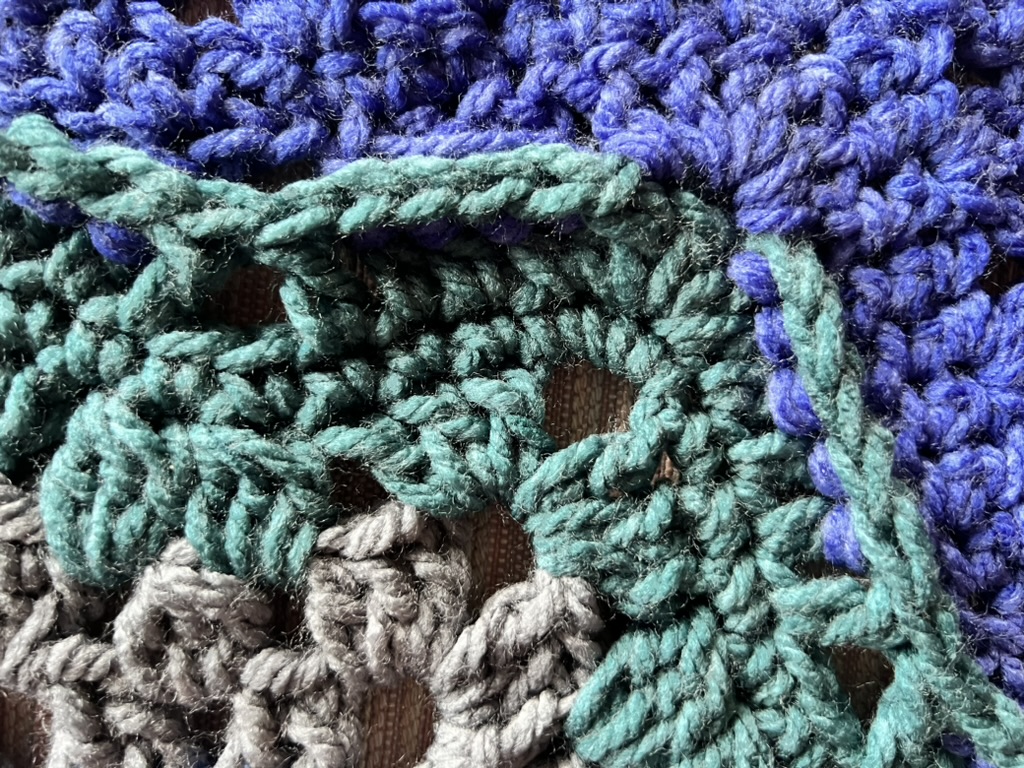
This pattern is provided free with advertisements on this page. If you would like an ad-free .pdf, you can purchase one at the bottom of the page. The .pdf is the same as this pattern, with the exception of the ads.

An international community of yarnful makers and friends.
- New pattern pre-releases
- Exclusive patterns never released to the public
- Have access to Betty’s ad-free .pdf library of patterns (3-4 patterns/month)
- Access to Betty’s Design Workshop
- Uplevel your knitting and crochet skills
- Enjoy regular crochet alongs, knit alongs, and classes
- Make like-minded friendships during our weekly social and educational events
- Bonus content every month
Tips for Completing in Six Days
To complete this project in six days, it will depend on how fast you crochet, what kind of yarn you use, and what size blanket you want to make. Most crocheters will need to work 2-4 hours each day. On the first day, do the Setup Rounds and the first repeat, after that do at least one repeat per day. Blankets with more than six pattern repeats will probably take longer than six days, or more than 4 hours per day to complete.
First Timers
If this is your first time making a 6-Day Star Blanket or 6-Day Crochet project, welcome to the club. While you may be tempted to just follow the video tutorials on YouTube and ignore this pattern, I don’t recommend it. The tutorials are meant to help you understand this pattern, but they are not intended to replace this pattern or be used without it. You will need to read this whole pattern and follow instructions here for the best possible outcome.
If something isn’t working or your counts are off, resist the temptation to just keep going without understanding where your mistake was made. This pattern should work out as written, if it doesn’t you’ll only set yourself up for future frustration if you just fudge it and keep going. Help is available in my Facebook Group and Membership Community, so if you get stuck come find me there.
This is an easy pattern but it is not a beginner pattern. I assume you already know how to chain, single crochet, and double crochet, and I don’t teach those skills in this pattern. There are plenty of resources online and elsewhere to learn those beginning crochet skills, so even very new crocheters can make a 6-Day Star Blanket.
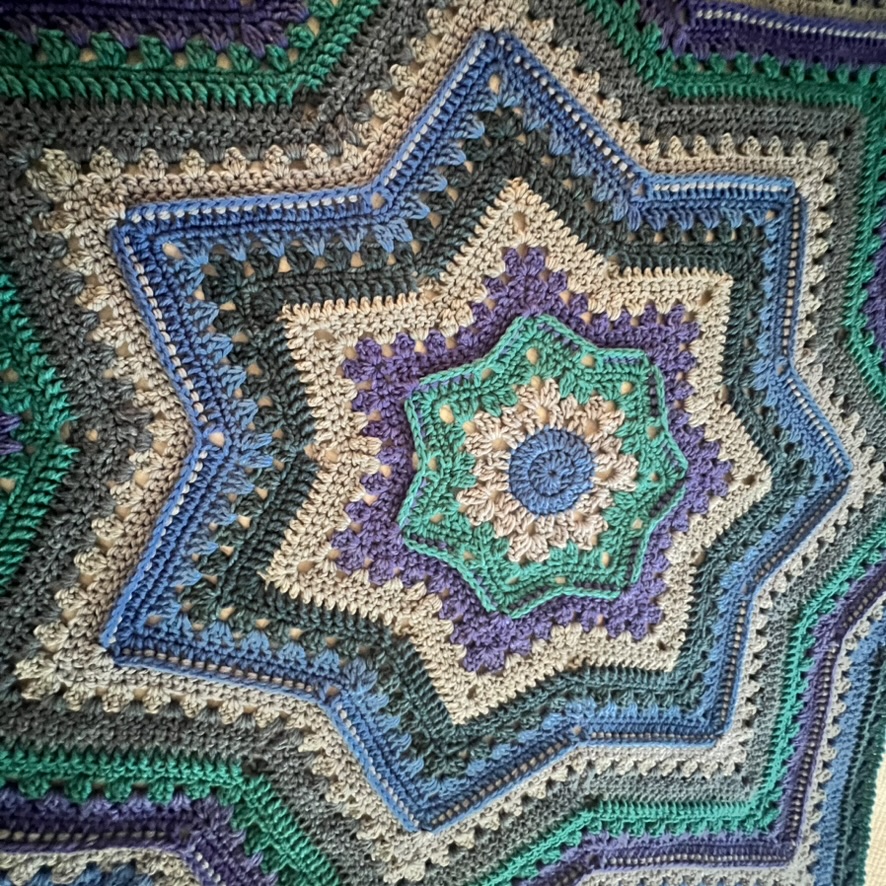
About the Row/Round Numbers
There are dozens of 6-Day Crochet patterns, and in order to provide consistency across all of the 6DKB variations, I’ve numbered the rows to correspond to the original 6-Day Kid Blanket. The cluster rows are always Row or Round 2 and 3, the dc rows are always Row or Round 5 and 6, and the sc rows are always Row or Round 4 and 7. This makes it easy to adapt any pattern to the many ways there are to stripe your 6-Day Kid Blanket.
You will be guided to work the rows in the proper order; don’t let the numbers throw you off or overthink a change in the sequence.
You will start with nine Setup Rounds which you will only work once. After that, you will repeat Rounds 2-7 until your blanket reaches the size you would like it to be. Do not repeat the Setup Rounds.
About the Ridgy Didge
The special textured ridge is created by turning the work, changing colors, and working FPdc. The ridge will appear on alternate sides of the work creating a blanket with no right or wrong side. If you prefer to have all the ridges on one side of the work, do not turn at all and use BPdc (Back Post double crochet) instead of FPdc.
When changing colors on the Ridge Round, take care to join the new color one dc after the sk 2 in the bottom of the valley.
It is possible to make this blanket using a solid color or cake yarn so that you don’t have to change colors or weave in ends. Additional instructions are given for continuous work for crocheters using solid color or cake yarn.
Changing colors
This pattern gives color changes every three rounds for an unspecified number of colors. When changing colors, fasten off the old color. Rotate the work and begin the next color with a standing stitch in a different valley.
When changing colors between Setup Rounds 7 and 8 and Rounds 5 and 6 for the Ridgy Didge Round, you will also turn the work over. The ridge round will appear on alternating sides of the blanket. You will only turn after the first dc round of each repeat (Setup Round 7 and Round 5).
This pattern also works as a solid color or with cake yarn, however, the first 6-9 rows of this version look best when the yarn does not change colors in the middle of a round. If you are using cake yarn, you may want to purchase an extra cake so you can control colors for at least the first few rounds. After the center is complete, mid-row color changes are not obvious.
You will not need to fasten off and re-join if you are using cake yarn. Follow the instructions “For Continuous Color/Cake Yarn Crocheters Only” tips to continue working without fastening off.
Join one of my online communities to knit and crochet along with friends, get help with pattern questions, show off your makes, and access tons of free resources for making 6-Day Crochet and other Betty McKnit designs.
Joining the rounds
Take care that you do not create extra stitches when you join your rounds, especially the sc rounds. I suggest using stitch markers to mark the first and last stitches of each round to avoid working into the sl st or ch 1 at the start of the sc rounds.
If you are working continuously (solid or cake yarn, and not changing colors deliberately) there will be times when you will be asked to insert the hook from the back to the front when joining with a slip stitch. See Special Stitches for an explanation on how to do this.

Begin Pattern
With any color and smallest hook, ch 4, join with sl st to form a ring (magic ring not recommended).
Set-up Round 1: ch 3 (counts as dc here and throughout), 13 dc into ring. Join with sl st to top of ch 3. (14 dc)
Set-up Round 2: ch 3, dc in same st. 2 dc in each st around. Join with sl st to top of ch 3. (28 dc)
Change Colors

Set-up Round 3: ch 3, dc in next st, *ch 3, dc in next 2 sts, ch 1, ** dc in next 2 sts, repeat from * around, ending last repeat at **, join with sl st to top of ch 3. <28 dc, 7 ch-3 sps , 7 ch-1 sps>
Setup Round 4: sl st in next dc and ch-3 sp, (ch 3, 2 dc, ch 3, 3 dc) in same sp, *dc3tog in ch-1 sp, (3 dc, ch 3, 3 dc) in ch-3 sp, repeat from * around, dc3tog in last ch-1 sp, join with sl st to top of ch 3. <14 3-dc clusters, 7 ch-3 sps, 7 dc3tog>
Change Colors

Setup Round 5: sl st into the gap just below your hook, between the dc3tog and the 3 dc, (ch 2, dc2tog) in same sp, *(3 dc, ch 3, 3 dc) in ch-3 sp, **dc3tog in next 2 sps, repeat from * ending last repeat at **, dc3tog in last sp, join with sl st to top of dc2tog cluster (be sure to join in the top of the cluster and not to the ch 2, here and throughout). <14 3-dc clusters, 7 ch-3 sps, 14 dc3tog>
Setup Round 6: ch 1, sc in same st, sc in each st around, working 3 sc in ch-3 sps. Join with sl st to first sc (be sure to join to the top of the sc and not the sl st, here and throughout).<77 sc>
If you experience curling during the setup rounds, change to a .5 – 1 mm larger hook. Remember to lay your work down after every round and “admire it,” and while you’re admiring, check for curling.
Setup Round 7: sl st in next st, ch 3, dc in next 3 sts, *(5 dc in center sc from round below), dc in next 4 sts,** sk 2, dc in next 4 sts, repeat from * ending last repeat at ** sk 2, join with sl st to top of ch 3. <91 dc> Fasten off.


For Continuous Color/Cake Yarn Crocheters Only: If you’re using one color or cake yarn, insert the hook from the back of the work and join with sl st from to top of ch 3. Turn, but do not fasten off.
Change Colors
Setup Round 8: Join with standing FPdc to second dc after any sk 2 in any valley, (for solid color or cake yarn, sl st in next dc, sl st around the FP of the next dc, ch 3,) FPdc in next 4 sts, *5 dc in next st (should be center dc in round below) FPdc in next 5 sts, sk 2,** FPdc in next 5 sts, repeat from * ending last repeat at **, join with sl st to top of standing FPdc. <105 sts>
Tip: Mark your last FPdc.

Setup Round 9: ch 1, sc in same st and each st around, making 4 sc in each peak in the center st of the 5 dc from the row below. Join with sl st to first sc. <126 sc>
Tip: Mark your first sc of the round. When you get to your last marked FPdc, that is your last sc. Skip over the sl st and the ch 1 that might look like they could be stitches, and join to the marked sc at the start of the round.

Setup Rounds Complete. Proceed to Round 2.
In order to make the row numbers correspond to the original 6-Day Kid Blanket row numbers, we are calling the next row Round 2. Round 2 corresponds to 6DKB row 2, and Round 3 to 6DKB Row 3, etc. Don’t let the change in sequence confuse you, proceed from Setup Round 9 to Round 2.

Round 2: ch 2, dc2tog cluster in same st (mark this st), *[sk 2, 3 dc in next st] 2 (4, 6, 8, 10, 12, 14, 16, 18, 20) times, sk 2, (3 dc, ch 3, 3 dc) in third of 4 sc in peak, [sk 2, 3 dc in next st] 2 (4, 6, 8, 10, 12, 14, 16, 18, 20) times, sk 2, ** dc3tog in the next st (should be the very center of the valley) repeat from * ending last repeat at **, join with sl st to marked dc2tog. <42 (70, 98, 126, 154, 182, 210, 238, 262, 290) 3 dc clusters, 7 ch-3 sps, 7 dc3tog>
Stitch counts in parentheses indicate subsequent repeats of the pattern.
Change Colors
Round 3: sl st in next sp, ch 2, dc2tog in same sp (mark this st), *3 dc in each of next 2 (4, 6, 8, 10, 12, 14, 16, 18, 20) sps, (3 dc, ch 3, 3 dc) in ch-3 sp, 3 dc in each of next 2 (4, 6, 8, 10, 12, 14, 16, 18, 20) sps, ** dc3tog in each of next 2 sps (one before and one after the dc3tog in the round below) repeat from * ending last repeat at **, dc3tog in last sp. Join with sl st to marked dc2tog. <42 (70, 98, 126, 154, 182, 210, 238, 262, 290) 3 dc clusters, 7 ch-3 sps, 14 dc3tog>
Round 4: ch 1, sc in same st, sc in each st around, working 3 sc in each ch-3 sp. Join w sl st to first sc. <20 (32, 44, 56, 68, 80, 92, 104, 126, 138) sc between each peak, 3 sc in each ch-3 sp>
On subsequent sc rounds, the number of scs between each peak will increase by 12. The numbers in parenthesis show the number of scs on each subsequent repeat of the pattern.
Round 5: sl st in next st, ch 3, dc in next 9 (15, 21, 27, 33, 39, 45, 51, 57, 63) sts, *5 dc in center sc in peak, dc in next 10 (16, 22, 28, 34, 40, 46, 52, 58, 64) sts, sk 2, ** dc in next 10 (16, 22, 28, 34, 40, 46, 52, 58, 64) sts, repeat from * ending last repeat at **, join with sl st to top of ch 3. <20 (32, 44, 56, 68, 80, 92, 104, 126, 138) dc between each peak, 5 dc in each peak st>
Fasten off.

Round 6: Join with standing FPdc to second dc from any sk 2 sp in valley, (for continuous/cake yarn, sl st in next dc, sl st around the FP of the next dc, ch 3), FPdc in next 10 (16, 22, 28, 34, 40, 46, 52, 58, 64) sts, *5 dc in next st, FPdc in next 11 (17, 23, 29, 35, 41, 47, 53, 59, 65) sts, sk 2, ** FPdc in next 11 (17, 23, 29, 35, 41, 47, 53, 59, 65) sts, repeat from * ending last repeat at **, FPdc in next 11 (17, 23, 29, 35, 41, 47, 53, 59, 65) sts, join with sl st to top of ch 3. <22 (34, 46, 58, 70, 82, 94, 106, 118, 130) FPdc between each peak, 5 dc in each peak st>
On subsequent rounds 5 and 6, the number of dcs or FPdc on either side of the mountain will increase by 6. The numbers in parenthesis show the number of dcs or FPdc on each subsequent repeat of the pattern.

Round 7: : ch 1, sc in same st and each st around, making 4 sc in each center of 5 dc in the peak. (Since we are working on all right sides and not turning, the top of the center dc is above and slightly to the right of the center stitch). Join with sl st to first sc. < 26 (38, 50, 62, 74, 86, 98, 110, 122, 134) sc between each peak and 4 sc in each center dc st>
Repeat Rounds 2-7 for pattern, changing colors after round 2, and turning the work and changing colors in sequence after Round 5 each time (do not repeat the setup rounds.) Work in the color sequence of your choice (I changed randomly). Work approximately 3 repeats for baby blanket size, and 5 repeats for a throw size, or continue to the size you desire.
I have given you stitch counts for 10 repeats. You do not have to do them all.
Continue to Finishing.
Finishing
Work a round of rsc to edge the blanket, skipping one stitch every 4-5 stitches if your blanket edge ripples.
If you have difficulty with rsc, you can try twisted single crochet, which is the same stitch done differently.
Fasten off. Weave in all ends.

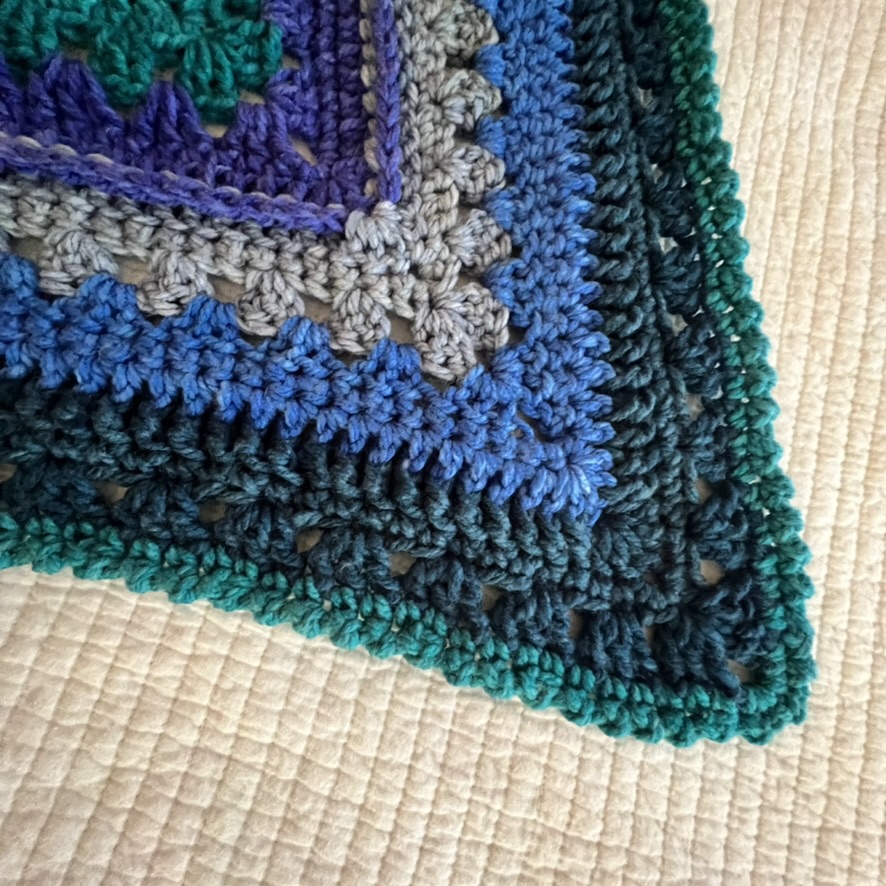
Ridgy Didge Concept by Diane Kagay. Pattern tested by Velinda Straub and Tracy Settle
This pattern is the intellectual property of Beth McKee Elliott aka Betty McKnit®. This pattern, The 6-Day Kid Blanket, 6-Day Crochet™, 6-Day Star Blanket™, and all derivative works are protected by copyright. Publishing translations, corrections, variations, or tutorials of this pattern, online or elsewhere without written permission from the owner is a violation of copyright.
Items created with this pattern may be used for commercial sale with credit to Betty McKnit in your listing. Mass production is not permitted.
©Beth McKee Elliott/Betty McKnit®
www.bettymcknit.com

